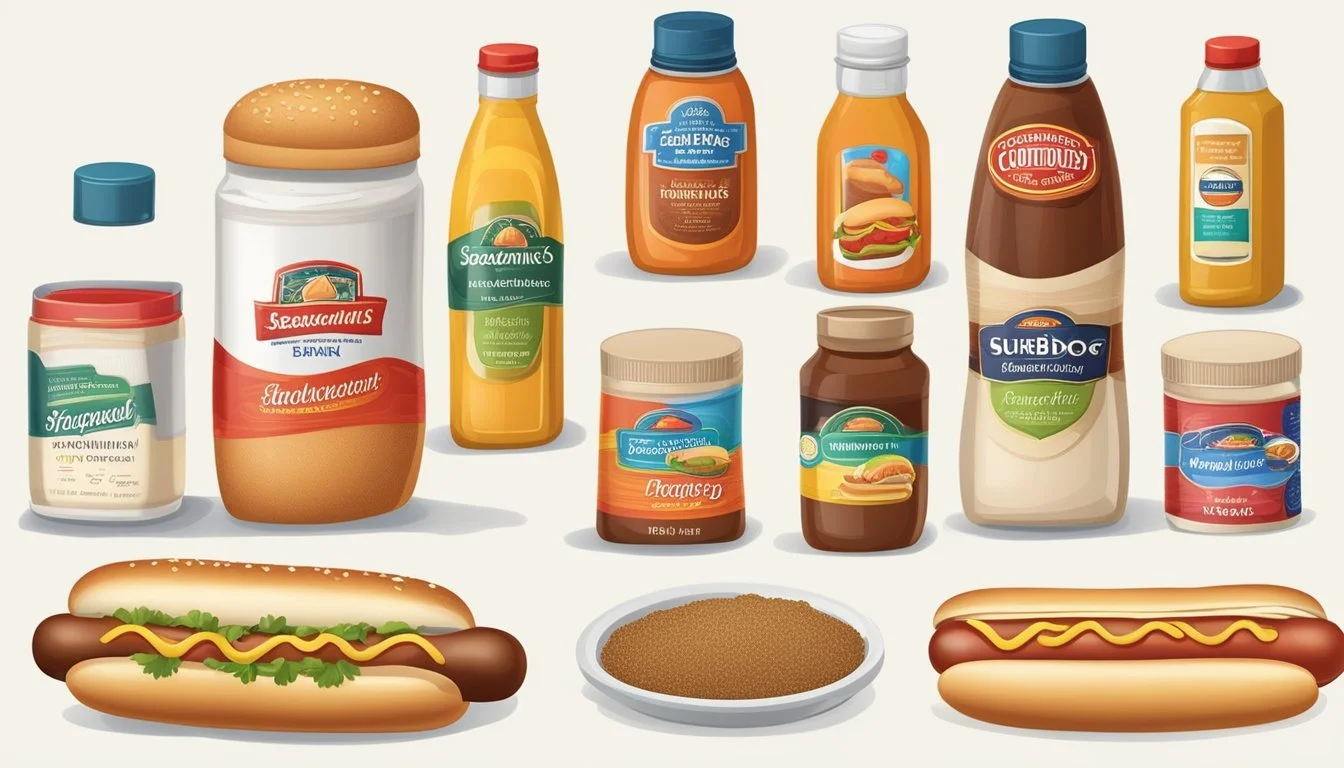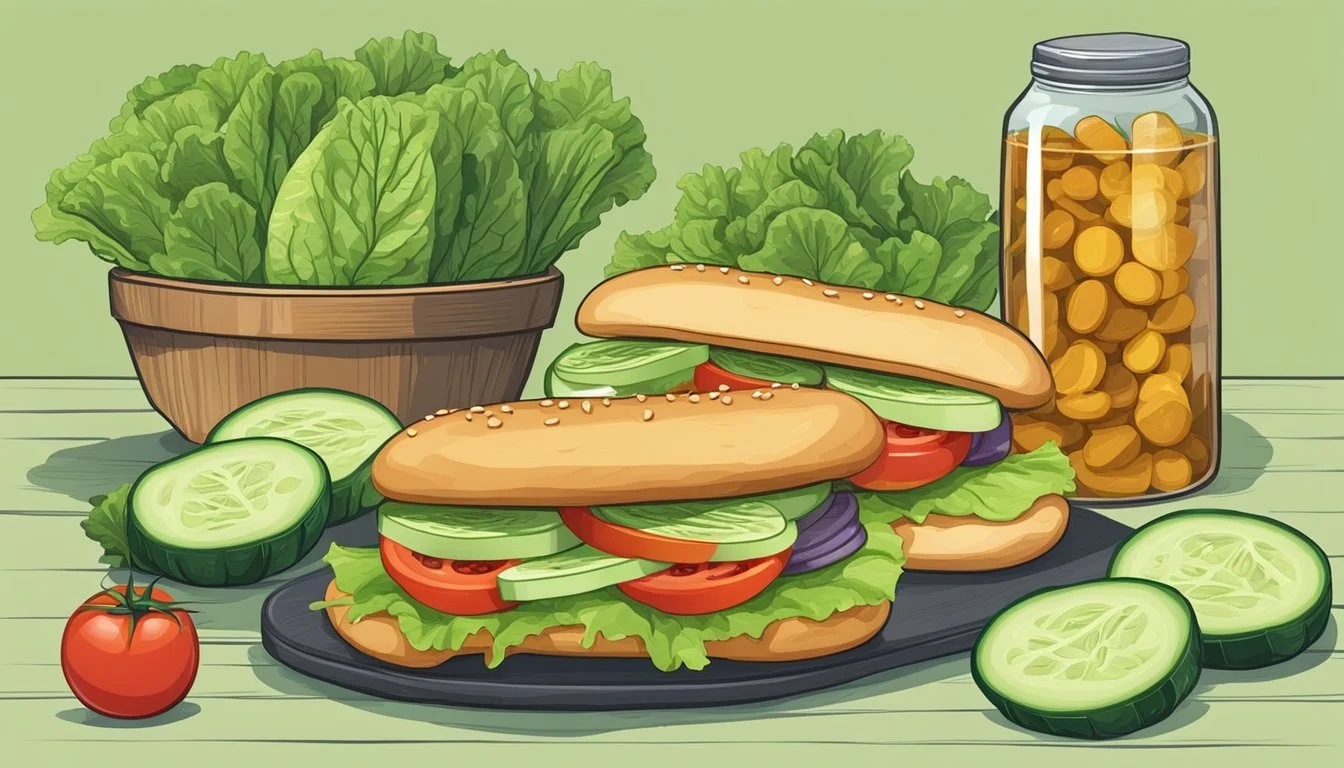Hot Dog Bun Substitutes
Innovative Alternatives for Your Next Cookout
When it comes to enjoying hot dogs, traditional buns may not always be available, or perhaps one seeks to explore new flavors and textures. This has paved the way for a variety of alternatives that can elevate the humble hot dog to a new culinary experience. From classic recipes to innovative pairings, these substitutes not only solve the problem of missing buns but also add exciting twists to the hot dog.
Options range from wrapping hot dogs in crescent roll dough and baking them until golden, to giving them a south-of-the-border twist with a warm tortilla, pinto beans, jalapeños, guacamole, or salsa. A hot dog nestled in a hard taco shell offers a contrasting crunchy texture while integrating different cultural tastes with this American classic. For those seeking healthier versions, swapping out the bun for leafy greens creates a hot dog salad that’s both nutritious and satisfying.
Thus, exploring alternatives to the hot dog bun is not merely about substituting the bread; it's an opportunity to transform the eating experience. Whether one opts for a fluffy naan wrap, a hearty grain-filled dish, or a simple, low-carb lettuce wrap, each substitute presents a unique way to enjoy hot dogs that might just become a new favorite.
Understanding Hot Dog Buns
The quintessential hot dog bun is an integral component of the classic hot dog experience, providing not just a vessel for the sausage but also contributing to taste, texture, and nutritional value.
Ingredients and Nutrition
Hot dog buns typically consist of ingredients like flour, yeast, sugar, salt, and sometimes milk, which contributes to their soft, pillowy quality. From a nutritional standpoint, they are a source of calories and carbohydrates. Traditional buns may contain limited amounts of fiber and protein, whereas whole-grain varieties offer a higher fiber content, essential for digestive health. Concerns over gluten may lead individuals to seek out alternatives made from gluten-free flour blends.
Ingredients:
Flour (may be wheat or alternative gluten-free options)
Yeast
Sugar
Salt
Optional: Milk for a richer flavor
Nutrition Profile (per average bun):
Calories: Approximately 120-150
Protein: 3-5 grams
Fiber: Less than 1 gram (higher in whole-grain options)
Contains varying amounts of other nutrients depending on the type of flour used.
Role in Hot Dog Enjoyment
Buns play a crucial role in hot dog enjoyment, offering not only a practical means to hold and consume the hot dog but also by enhancing the overall flavor profile. The bun should complement the saltiness and savoriness of the hot dog and can either add to the textural contrast with a slight crust on the outside or contribute a gentle, soft contrast to the meat's texture. Their physical structure is important as well; a good bun will hold together well without being too dense or too airy, ensuring that it does not detract from the hot dog itself.
Traditional and Alternative Ingredients
Innovative hot dog bun substitutes not only introduce a variety of flavors and textures but also cater to different dietary needs, from low-carb lifestyles to gluten sensitivities. Flour diversity and enhancements pave the way for these alternatives, each contributing distinct nutritional profiles and characteristics to the final product.
Flour Varieties
Traditional hot dog buns are typically made from white wheat flour, which offers a soft texture and mild taste. However, alternative flours such as whole-wheat, rye, and oats introduce more fiber and nutritional advantages, offering a heartier texture and enhanced flavor. For those monitoring their calorie and carbohydrate intake, considering the flour base is crucial.
Whole-Wheat Buns: Higher in fiber and may contribute to feeling satiated longer.
Rye: Dense, flavorful, and typically lower in calories than white flour.
Oats: Provide a unique taste and increase the overall nutritional value, including protein and fiber content.
Dough Enhancers
Enhancers like olive oil can be added to hot dog bun dough to improve its flavor and texture. Cheese is another option that not only introduces a burst of flavor but also adds extra protein and saturated fat to the dough. These ingredients alter the classic bun recipe, infusing new life into traditional offerings.
Enhancer Effect Olive Oil Provides moisture and rich flavor; may also contribute to a softer dough. Cheese Adds taste complexity and boosts protein; affects melting properties and dough elasticity.
Low-Carb and Gluten-Free Options
Responding to the demand for low-carb and gluten-free diets, manufacturers and home cooks alike are experimenting with ingredients such as almond flour, coconut flour, and ground flaxseed. These alternatives greatly reduce the carbohydrate content and eliminate gluten, making them suitable for individuals with gluten intolerance or those on a low-carb diet.
Almond Flour: Low in carbohydrates and gluten-free, with a high protein content.
Coconut Flour: Offers a low-carb alternative, high in fiber, but requires more liquid.
Ground Flaxseed: Gluten-free, high in omega-3 fatty acids, contributes to reducing net carbs.
Preparation Methods
In this section, readers will uncover how to perfectly prepare hot dog bun substitutes to maximize flavor and achieve ideal textures. Precision in heating and cooking methods ensures that alternatives to traditional buns are not only suitable but also delicious.
Baking Fundamentals
When opting to bake a substitute for a classic hot dog bun, preheating the oven is a crucial step. Preheat your oven to the recommended temperature—usually between 350-375 degrees Fahrenheit—before attempting any recipe. To prevent drying out or burning, items such as crescent roll-wrapped hot dogs should be baked on the middle rack, for 12-15 minutes or until golden brown. It's important to check regularly for doneness to maintain quality.
Baked alternatives like whole-grain buns benefit from a brief period in the oven, as it enhances their texture. If using a heavier dough, such as one for Naan, allow it to rise before molding it around the hot dog and baking. The typical baking time at 350 degrees may extend to 20 minutes, followed by a quick broil to achieve a crisp exterior.
Cooking Techniques for Alternatives
For those who want to step away from the oven, various cooking techniques offer equally exciting results. Tortillas, for example, could be toasted in a pan or in an oven wrapped in foil at 350 degrees for about 10 minutes, to create a snug, warm wrap for hot dogs.
A cookout ambiance can be achieved by marinating alternative bun options like large lettuce leaves or even portobello mushroom caps. Marinate these substitutes in a flavorful dressing before briefly grilling or searing them to impart a smoky taste that mimics traditional grilling methods.
Hot Dog Bun Alternatives
Exploring various hot dog bun substitutes can enhance the culinary experience by introducing new flavors and textures. From bread-based options to more novel pairings, these alternatives provide creative ways to enjoy a classic.
Bread-Based Substitutes
Tortillas: A soft tortilla can be warmed and used to wrap around the hot dog, infusing a Mexican-inspired twist to the meal.
Crescent Roll: Encasing a hot dog in crescent roll dough and baking produces a savory, flaky treat.
Croissant: Swapping the traditional bun for a buttery croissant lends a French flair to the hot dog.
English Muffin: An English muffin’s nooks and crannies offer a toasty, crunchy alternative.
Pretzel Roll: The hot dog can find a hearty companion in a dense and salty pretzel roll.
Baguette: Using a segment of a crusty baguette grants a chewy texture and artisanal quality.
Vegetable and Protein-Based Options
Lettuce Wraps: A large leaf of lettuce can serve as a low-carb substitute enveloping the hot dog in a fresh, crunchy bite.
Unconventional Creations
Cornbread: Serving the hot dog with cornbread invites a Southern twist, combining sweet and savory notes.
Waffles: Placing a hot dog between two waffles creates an unexpected merger of breakfast and lunch elements, ideal for brunch.
Seasoning and Condiments
Enhancing hot dogs with the right seasonings and condiments can elevate them from simple fare to culinary delights. Carefully selected toppings and sauces can add layers of flavor, transforming the humble hot dog into a gourmet experience.
Classic and Creative Toppings
Classic toppings such as ketchup, mustard, and relish are staple condiments that remain favorites for hot dog enthusiasts. They cater to those who cherish tradition while offering a familiar tang and sweetness to the palate. For a more savory appeal, onions, cheese, and chili provide a rich depth of taste.
In the realm of creativeness, one might explore the use of Dijon mustard or salsa for a unique twist. Fresh pickles or jalapeño peppers can introduce a satisfying crunch and a kick of spice. Guacamole lends a creamy texture and is excellent for those who prefer a milder yet flavorful addition.
Sauces and Spreads
Beyond the classic condiments, a variety of sauces and spreads can be applied to complement the hot dog. BBQ sauce introduces a smoky sweetness, perfect for those that enjoy a touch of Southern flair. Those with a penchant for Middle Eastern flavors may opt for hummus as a spread, providing a smooth, garlicky layer.
For an added punch, Thai sweet chili sauce or hot sauce can be drizzled over the hot dog for both heat and sweetness. A simpler approach may involve a sprinkle of salt and pepper to enhance the natural flavors of the meat and the bun substitute. Each sauce or spread can create a distinct taste profile, ensuring every bite is as delicious as it is memorable.
Accompaniments and Side Dishes
When selecting side dishes to serve with hot dogs, one should consider flavors that complement the main dish. Sides can range from classic comfort foods to healthier alternatives, each enhancing the hot dog experience in its own way.
Complementary Foods
Baked Beans: A staple accompaniment, baked beans offer a sweet and savory flavor that pairs well with the saltiness of hot dogs. For a heartier option, one might add ground beef and bacon to their baked beans.
Pickles: Their tangy crunch provides a refreshing contrast to the soft bun and savory frank.
Bacon: Wrapping franks in bacon adds a smoky depth.
Sauces & Toppings: Onions and bell peppers sautéed until soft can be used as toppings along with a variety of condiments to tailor to personal taste.
Healthy Alternatives
Vegetables:
Lettuce: It can be used as a bun substitute or added for a fresh, crispy texture.
Steamed Broccoli: High in protein and vitamin C, it adds a healthy, vibrant side without overwhelming the main dish.
Other Alternatives:
Pickles: Again, pickles offer not only a crunchy texture but also a low-calorie option.
Bacon: For those who want a healthier twist on bacon, consider using turkey bacon for fewer calories but still keeping the flavor.
Dietary Considerations
When choosing hot dog bun substitutes, one should consider both the nutritional impact and specific dietary needs. Whether an individual is looking to reduce calories or accommodate a dietary restriction, the alternatives available provide varied nutritional content and can cater to different health requirements.
Health-Conscious Choices
For those aiming to maintain a low-calorie diet, it's important to seek substitutes that are high in fiber and protein but lower in saturated fat, sodium, and calories. Whole grain wraps or lettuce leaves serve as a nutritious replacement offering essential nutrients with fewer carbohydrates. These options increase the feeling of fullness without the extra calories usually found in traditional buns.
Lettuce Wraps: High in fiber, low in carbohydrates, and negligible in saturated fat.
Whole Grain Wraps: Rich in fiber and provide a good source of protein, but one must also consider the carbohydrate content.
Customizing for Dietary Restrictions
Individuals with dietary restrictions, such as gluten intolerance or those following a vegan lifestyle, require substitutes that adhere to their specific dietary rules without compromising on nutrition.
Gluten-Free: Gluten-free options like corn tortillas or gluten-free bread variations are suitable for those with celiac disease or gluten sensitivity. These products cater to the need for low-gluten diets while also providing a source of carbohydrates.
Substitute Carbohydrates Protein Fiber Corn Tortillas Moderate Low Low Gluten-Free Buns Variable Variable High
Vegan: For vegans, alternatives such as portobello mushrooms or plant-based flatbreads ensure no animal products are included, while also providing a way to enjoy a hot dog. They can be high in fiber and protein, and depending on the ingredients, may also be low-carb.
Portobello Mushroom: A savory option with minimal calories and high nutritional value.
Plant-Based Flatbread: Can be a source of protein and fiber if made with whole grains and seeds.
Cookout and Party Planning
When planning a cookout or party, the menu often revolves around classic favorites like franks. Providing alternatives to traditional hot dog buns can elevate the experience and cater to diverse tastes.
Serving Suggestions
For hosting a memorable cookout, one must consider how the franks will be served. Here are suggested alternatives to standard buns that not only add variety but can also incorporate exciting flavors:
English Muffins: Lightly toasted and brushed with olive oil can create a sophisticated twist.
Tortillas: A nod to Mexican cuisine, warmed tortillas wrapped around hot dogs make for a fun and casual option.
Themed Variation Ideas
Themed cookouts provide an opportunity for creativity, and hot dog bun alternatives can contribute to the overall experience:
Mexican Fiesta: Utilize tortillas and top your franks with beans, jalapeño peppers, and guacamole.
European Delight: Using English muffins, serve franks with toppings like sauerkraut and spicy mustard.
Organizers should not forget to publicize these alternative options in their cookout newsletter to excite guests.
Recipe Innovations
When seeking to enrich one's culinary experience with hot dogs, one must not overlook the potential of recipe innovations. By experimenting with new carriers for the classic frank, enthusiasts can discover a spectrum of flavors and textures to elevate their hot dog game.
Alternative Hot Dog Recipes
Crescent Roll Hot Dogs: A simple and delicious twist can be achieved by wrapping hot dogs with crescent roll dough. One places the wrapped hot dogs on a rimmed baking tray and bakes at 375 degrees Fahrenheit for approximately 12-15 minutes.
Ingredients:
Hot dogs
Crescent roll dough
Instructions:
Preheat the oven.
Wrap the hot dogs.
Bake until golden.
Tortilla-Wrapped Hot Dogs: For a touch of Tex-Mex flair, one can opt for a tortilla instead of the typical bun. Warming up a tortilla, placing a hot dog within, and adorning it with toppings like pinto beans, jalapeño peppers, guacamole, or salsa can create a flavor-packed meal.
Steps:
Heat the tortilla
Insert the hot dog
Add preferred toppings
Homemade Bun Creations
Softness with Homemade Vegan Buns: The texture of a hot dog bun significantly enhances the eating experience. Crafting homemade vegan buns using ingredients like aquafaba can result in a dough that is soft, smooth, and supple.
Key Components:
Aquafaba
Vegan butter
Bread hook for mixing
Utilize a Hot Dog Bun Pan: For bakers who appreciate precision and uniformity in their bun creations, using a hot dog bun pan can be effective. They provide the structure necessary to achieve the classic bun shape, with the added benefit of customizing the flavorful dough.
Varied Bun Alternatives: Options like English muffins, pretzel bread, or pizza crust can serve as inventive bun replacements. Consider grilling slices of pizza crust for added flavor and crispness or creating waffles from batter seasoned with herbs and a drizzle of syrup for a sweet and savory profile.
Bun Alternatives Suggestions:
English muffins
Pretzel bread
Grilled pizza crust slices
Savory herb waffles
Culinary Trends and Culture
In the landscape of American cuisine, hot dogs have maintained their popularity, evolving in presentation and the choice of buns used. This section navigates through the enduring appeal of hot dogs and explores how contemporary trends are reshaping their consumption.
Popularity of Hot Dogs and Their Buns
Hot dogs are a staple of American culture, widely consumed at sports events, barbecues, and street vendors. The traditional hot dog and bun combination is iconic, often enjoyed with a variety of toppings that reflect the regional flavors of the United States. The classic bun serves not only as a vessel for the hot dog but also contributes to the overall flavor and texture of the dish.
Classic Bun: Soft, slightly sweet, and fluffy, designed to complement the savory hot dog.
Cornbread: Offers a Southern twist, providing a sweeter, more textured alternative.
Emerging Trends in Hot Dog Consumption
Consumers today seek variety and health-conscious options, prompting the emergence of fresh and flavorful alternatives to the conventional bun.
Crescent Roll: Wrapping hot dogs in crescent roll dough for a buttery and flaky experience.
Lettuce Wrap: A low-carb option that adds a crisp texture and a healthy twist to the traditional hot dog.
In recent years, newsletters and food blogs have been instrumental in circulating innovative recipes, contributing to a shift in how people enjoy hot dogs. These recipes often emphasize adventurous and alternative approaches, broadening the horizons of hot dog aficionados.
Recipes: Encouraging experimentation with a range of bun substitutes that maintain or elevate the hot dog's flavor profile.
Table: Hot Dog Bun Alternatives Spotlight
Bun Alternative Description Flavor Profile Crescent Roll Wrap hot dog in the crescent dough Buttery and flaky Lettuce Use a lettuce leaf as a wrap Fresh and crunchy Cornbread Serve in cornbread instead of bun Sweet and hearty
This move towards alternative options reflects consumers’ desires for modified versions of the hot dog that cater to dietary preferences and culinary curiosity, all while preserving the essence of this beloved food item.











